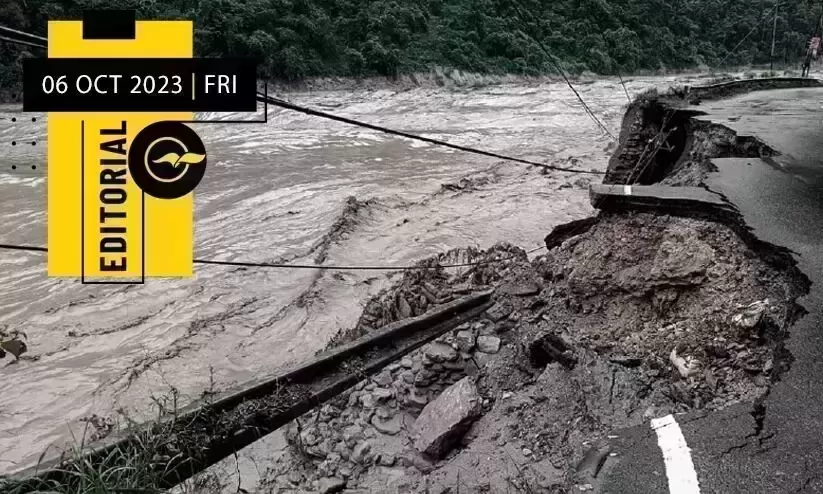
Washed away in flash floods
text_fieldsThe entire northeastern state of Sikkim has been devastated by the flash flood caused by the glacier lake overflow. According to initial reports, more than 100 people, including 23 soldiers, have been washed away in the flood. 11 bridges were wiped away. 22,000 people, according to officials, have been impacted by the catastrophe. Three thousand tourists, including those from Kerala, are stranded. The South Lhonak Lake, a glacial lake in the upper reaches of Sikkim, burst its banks following a cloudburst in the area. This caused the Teesta River to overflow its banks and resulted in a massive flood. The actual statistics of loss of life and property are yet to be obtained as the communication system to the heavily damaged Chungthang and Mangan districts has been disrupted. The initial reports state that extreme rains or snowfall as part of the monsoon season in North India and Northeast states may have caused the turbulence of the ice lake and the subsequent flooding. Experts say that the earthquakes in Nepal and some parts of northern India in the past may also have contributed to this unexpected bursting. Concerns have been raised that the danger level may worsen as a result of the destruction of a part of the Chungthang Hydro Dam, a vital part of the Teesta III Project, a key hydropower project with a 1200 MW capacity.
Rescue activities are being carried out in the impacted areas under the leadership of the army and the National Disaster Response Force (NDRF). Concerns about natural disasters becoming more frequent in the Himalayan plateau states are being raised after the flood in Sikkim. The latest disaster shows that, in addition to climate change, an increase in development activities without taking into account the terrain and environment is another factor contributing to the frequency of disasters. For the past ten years, several government agencies and scientific researchers have issued warnings about the potential for a Glacial Lake Outburst Flood (GLOF) at Lhonak Lake. Scientists at the Hyderabad-based National Remote Sensing Centre had warned in 2013 that Lhonak Lake, which is located at a height of 5,425 meters above sea level, is in an extremely precarious condition that could cause major disasters in the foothills. The report also highlighted the possibility of flash floods which may cause massive loss of life and property in townships like Chungthang, Rangpo, Singtam and Dikchu which are now submerged in flood. The severity of the situation was pointed out in a study conducted in August 2014 by the Snow and Avalanche Study Establishment (SASE), which studies snow and avalanches, and the Sikkim Department of Science and Technology and Climate Change. The report also suggested temporary solutions to reduce the atmospheric pressure of the ice lakes. A study conducted in September 2016 by a joint team comprising the Sikkim State Disaster Management Authority, the Indo-Tibetan Police Force, and the Students Education and Cultural Movement of Ladakh found that engineering intervention was not feasible in the area because of the threat of dead ice melting. A system of diverting water through polythene pipes was also devised to reduce the pressure in the lake.
Sikkim has 11 large glacial lakes covering an area of 44 hectares. The construction of dams is progressing day by day in the region which makes things more complicated as the scientific management of these is difficult. There are 81 large hydropower projects across ten states and two Union Territories in the Himalayan region, which is prone to active earthquakes. 32 are under construction and 320 big projects are in the pipeline. This is the estimate of the Central Electricity Authority under the Union Ministry of Power. Five of the 32 projects now underway are in Sikkim. According to India's own experience, hydropower developments aggravate the effects of natural disasters when cloudbursts happen. Arunachal Pradesh's Subansiri Dam, the country's biggest hydropower project, overflowed during heavy rains in June last year, submerging 100 villages in Assam. In 2021, 11 projects in Uttarakhand, Himachal Pradesh, Jammu and Kashmir and Ladakh were affected following cloudburst in the region. Even after the Dam Safety Act was passed in 2021 with the intention of preventing dam-related tragedies through regular monitoring, inspection, operation, and maintenance, the threat is not going away but rather getting worse. We will not be able to get out of the unfortunate situation of pointing fingers at one another after a tragedy only if we have a combination of the knowledge and awareness of the surrounding environment and the ability to manage the people and nature around us.


























